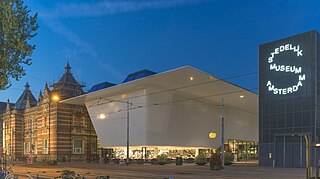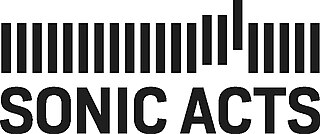Related Research Articles
An android is a humanoid robot or other artificial being often made from a flesh-like material. Historically, androids were completely within the domain of science fiction and frequently seen in film and television, but advances in robot technology now allow the design of functional and realistic humanoid robots.
COBRA or Cobra, often stylized as CoBrA, was a European avant-garde movement active from 1948 to 1951. The name was coined in 1948 by Christian Dotremont from the initials of the members' home countries' capital cities: Copenhagen (Co), Brussels (Br), Amsterdam (A).

A facial recognition system is a technology potentially capable of matching a human face from a digital image or a video frame against a database of faces. Such a system is typically employed to authenticate users through ID verification services, and works by pinpointing and measuring facial features from a given image.

Guillaume-Benjamin-Amand Duchenne was a French neurologist who revived Galvani's research and greatly advanced the science of electrophysiology. The era of modern neurology developed from Duchenne's understanding of neural pathways and his diagnostic innovations including deep tissue biopsy, nerve conduction tests (NCS), and clinical photography. This extraordinary range of activities was achieved against the background of a troubled personal life and a generally indifferent medical and scientific establishment.

The Stedelijk Museum Amsterdam, colloquially known as the Stedelijk, is a museum for modern art, contemporary art, and design located in Amsterdam, Netherlands.
Remko Jan Hendrik Scha was a professor of computational linguistics at the faculty of humanities and Institute for Logic, Language and Computation at the University of Amsterdam. He made important contributions to semantics, in particular the treatment of plurals, and to discourse analysis, and laid the foundations for what became an important research paradigm in computational linguistics, Data Oriented Parsing.

Satyendra Pakhalé is a designer, industrial designer and architect. He realizes projects from industrial design, applied research to design vision of the future, technologically challenging product development, manufacturing, highly crafted pieces, exhibitions and architecture. He works in the fields of product design, including consumer electronics, health care, aviation, mobility, home appliances, furniture, digital products & computers, and interior design and architecture. In 2008, he was selected as one of L’Uomo Vogue magazine's 80 most influential creative people with vision worldwide in design and architecture. His works are in permanent collections of several museums worldwide.

Dick Raaijmakers, also known as Dick Raaymakers or Kid Baltan, was a Dutch composer, theater maker and theorist. He is considered a pioneer in the field of electronic music and tape music, but has also produced numerous musical theater pieces and theoretical publications.
Mécanisme de la physionomie humaine. ou, Analyse électro-physiologique de l'expression des passions des arts plastiques. is a monograph on the muscles of facial expression, researched and written by Guillaume-Benjamin-Amand Duchenne de Boulogne (1806–75). It first appeared as an abstract published in Archives générales de médecine in 1862 and was then published in three formats: two octavo editions and one quarto edition. The work was an important resource used by Charles Darwin (1809–82) for his own study on the genetics of behaviour, titled The Expression of Emotions in Man and Animals, and in recent years it has been reclaimed as an important landmark in the history of the photographic arts.

The arts are a very wide range of human practices of creative expression, storytelling and cultural participation. They encompass multiple diverse and plural modes of thinking, doing and being, in an extremely broad range of media. Both highly dynamic and a characteristically constant feature of human life, they have developed into innovative, stylized and sometimes intricate forms. This is often achieved through sustained and deliberate study, training and/or theorizing within a particular tradition, across generations and even between civilizations. The arts are a vehicle through which human beings cultivate distinct social, cultural and individual identities, while transmitting values, impressions, judgments, ideas, visions, spiritual meanings, patterns of life and experiences across time and space.
Marc Bijl is a Dutch artist who lives and works in Berlin. His works are based upon social issues and their use of symbols and rules. This can result in interventions in the public space, sculptures or installations that undermine or underline this perception of the world.

Beatrix Ruf is a German art curator and art advisor who held the position of director of the Stedelijk Museum Amsterdam between November 2014 and October 2017. Formerly she was director of the Kunsthalle Zurich. She is associate editor for JRP-Ringier, works with the LUMA Foundation, the Garage Museum of Contemporary Art in Moscow, and is the artistic director of the Ringier Collection. In 2012, she was listed in the top ten of the most influential people in the art world by ArtReview.
Henry Vega is a composer and Electroacoustic musician from New York City, currently living in The Hague, Netherlands. He founded The Spycollective in 2006, a now defunct music, theater and dance group, and is a founding director of Artek Foundation. Vega has been composing and performing internationally since 2001 and is also a founding member of The Electronic Hammer trio with Diego Espinosa and Juan Parra Cancino. He is married to Polish composer Kasia Glowicka.

Hao Li is a computer scientist, innovator, and entrepreneur from Germany, working in the fields of computer graphics and computer vision. He is co-founder and CEO of Pinscreen, Inc, as well as associate professor of computer vision at the Mohamed Bin Zayed University of Artificial Intelligence (MBZUAI). He was previously a Distinguished Fellow at the University of California, Berkeley, an associate professor of computer science at the University of Southern California, and former director of the Vision and Graphics Lab at the USC Institute for Creative Technologies. He was also a visiting professor at Weta Digital and a research lead at Industrial Light & Magic / Lucasfilm.
Stedelijk Museum Bureau Amsterdam (SMBA) is a project space for contemporary art in Amsterdam, Netherlands. SMBA was founded in 1993 and is part of the Stedelijk Museum Amsterdam. It is the uccessor of Museum Fodor, a platform for young Amsterdam artists that ceased to exist in 1992. The goals of SMBA are to stimulate and signal contemporary art in Amsterdam and to create an international stage for this. SMBA organizes eight to ten solo and group exhibitions annually. The current head of Stedelijk Museum Bureau Amsterdam is Jelle Bouwhuis.

Sonic Acts is an organisation for the research, development and production of works at the intersection of art, science and theory. It also commissions and co-produces new works, often in collaboration with international festivals, arts organisations, funders and other partners.
Juul Kraijer is a Dutch visual artist. Her work has been exhibited internationally, and is included in major museum collections such as the Museum of Modern Art, New York City, the Museum of Old and New Art, Tasmania and the Kupferstichkabinett Berlin.
Alexandra Bachzetsis is a Greek-Swiss choreographer and visual artist Her artistic media include visual arts, dance, performance and theater.

Studio Drift is an Amsterdam-based artist duo founded by Ralph Nauta and Lonneke Gordijn in 2007. It specializes in choreographed sculptures and kinetic installations, with the focus to re-establish the connection between humans and earth.
Edwin van der Heide is a Dutch sound artist and composer known for his immersive installations and performances, currently living in Rotterdam.
References
- ↑ "Arthur Elsenaar". V2 Institute for the unstable media. Retrieved 12 September 2015.
- 1 2 "ArtScience Interfaculty". ArtScience Interfaculty. Retrieved 12 September 2015.
- ↑ Elsenaar, Arthur; Scha, Remko (2002). "Electric Body Manipulation as Performance Art: A historical perspective". Leonardo. 12: 17–28.
- ↑ "Perfect Paul - On freedom of facial expression (2012)". Code Matter(s). Retrieved 12 September 2015.
- ↑ "Face Shift". Stedelijk Museum Amsterdam. Retrieved 12 September 2015.